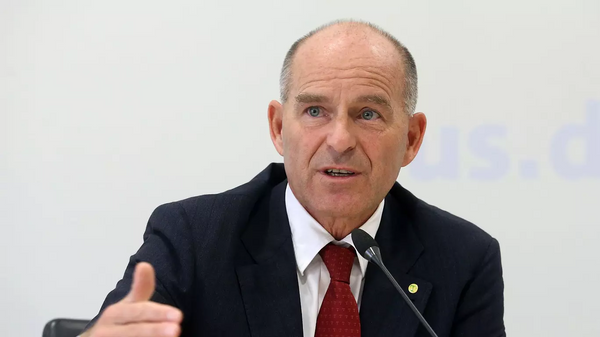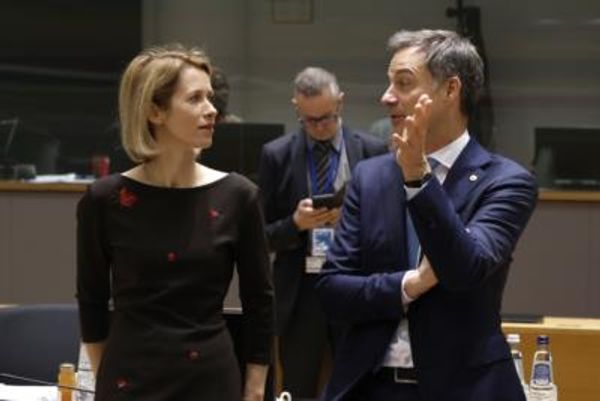
On a recent weekday morning, during the rush to get out the door, my husband, Ben, started telling me about a podcast he’d just heard on the health impacts of air pollution — seemingly oblivious to the shrieks of our 4-year-old, who couldn’t find the right socks, or the fact that our 7-year-old was pouring soggy Cheerios down the dog’s throat.
I wanted to snap at Ben. Instead, I willed myself to do something that felt unnatural: I “turned toward” my husband.
It was a strategy I’d learned from a new book by John and Julie Gottman, the renowned marriage researchers who famously claim they can guess with over 90% accuracy whether a couple’s relationship will last, and if they’ll be happy, after observing them for just 15 minutes.
Ben, who is a very good sport, had agreed to join me in trying the exercises in “The Love Prescription: 7 Days to More Intimacy, Connection and Joy,” so we could strengthen our marriage and so that I could write about our experience. Ben and I have been together quite happily for 19 years, but lately we have been consumed by parenthood.
“Turning toward” is the Gottmans’ No. 1 relationship hack. When one partner (in this case, Ben) makes an earnest “bid for connection,” the other partner has three choices: They can ignore the outreach (turn away); they can respond negatively (turn against); or they can acknowledge the bid positively (turn toward).
“Let’s say I say to John, ‘Wow, look at that beautiful bird out the window!’” Julie offered as an example during a recent Zoom call. “John can totally ignore me. He can say ‘Would you stop trying to interrupt me? I’m reading.’ Or he can say, ‘Wow, yeah!’”
A nod, a touch, even a “hmm” all count as turning toward.
According to the Gottmans, those small moments are deposits in a couple’s emotional bank account — their “love piggy bank” — that they can draw on in moments of conflict. Ben and I rolled our eyes at the saccharine analogy, but the Gottmans have decades of data to support the idea that brief moments of kindness and connection can predict marital happiness — much of it gathered at the Gottman Love Lab, the pioneering research center John co-founded in the 1980s at the University of Washington to study what makes romantic love last.
In one of the Gottmans’ best-known experiments, they invited 130 newlywed couples to spend a day hanging out in the lab (designed to look like a cozy home) and meticulously tracked their every interaction. The Gottmans checked on them after six years, and found a striking split: Those who remained together had turned toward each other 86% of the time in the lab. Those who ended up divorced did so only 33% of the time.
This is the allure of the Gottmans’ latest book — and of their work more broadly. Not only do they believe they have found the scientific foundation of lasting love, they think a whole lot of it boils down to how nice people are to their partners during small daily moments.
“No matter how frantic a day, there are always opportunities to turn toward,” the Gottmans write. “It costs very little in terms of time, and the payout is huge.”
That busy morning, I put their promise to the test. Instead of ignoring Ben or squawking at him for his lousy timing, I mustered up a tepid: “huh.”
“Yeah, thought you’d find that interesting,” said Ben, clearly pleased, and we returned to corralling the children.
Practicing what they preach
John, 80, is the data wonk of the two, having trained as a mathematician at MIT before pivoting to psychology. He married Julie, 71, in 1987. She is also a clinical psychologist though she focuses more on working with patients. She is John’s third wife; his two prior marriages ended due to significant incompatibility issues.
Together, they are a content machine. John has published more than 200 research papers, and between them, they have written more than 40 books. The pair also oversee The Gottman Institute, which offers workshops and training materials for couples and the hundreds of therapists who have been certified in their methods.
“I think of John Gottman as kind of like the godfather of some of the most foundational pieces of what are in relationship interventions today,” said Sarah Whitton, a professor at the University of Cincinnati and director of the Behavioral Health Center, who researches romantic relationships and psychological health.
“I think some relationship scientists may balk a little bit at some of the simplified statements that the Gottmans make coming out of research,” Whitton added. “We tend to say things much more tentatively.”
The Gottmans do tend toward sweeping, authoritative statements: They assert, for instance, that 69% of relationship problems never get solved. Or that there are four communication styles that can foretell the end of a relationship (criticism, contempt, defensiveness and stonewalling). Those kinds of claims might sound out of place at a research conference, Whitton said, but she admires the Gottmans’ ability to make their findings accessible to people seeking practical advice.
“I personally use their approaches all the time, not only as a therapist but as a person in relationships,” said Rafaella Smith-Fiallo, a licensed clinical social worker and sex and couples therapist in St. Louis, Missouri, who has trained in the Gottman Method. “I find them to be very practical and direct.”
The couple are, in many ways, their own best case study, offering a realistic example of what a thriving long term relationship looks like. During a rough patch early in their marriage, they saw a couples therapist for a handful of sessions, but the counselor clearly preferred John, he said. (“I thought she was a great therapist!” John recalled, smiling.) So they stopped going, and instead turned to their research for guidance.
“We have conflict. We have fights. There are times that we don’t like each other very much,” John said. “But we use these tools, and over time they really have become second nature.”
They turn toward each other “all the time,” Julie said. When John is reading his Kindle and shares something out loud, Julie will stop to listen. If she asks him to clean up something around the house, he says sure. And they are affectionate. During our video interview from their home in Portland, Oregon, where they spend time to be closer to their daughter, son-in-law and 8-month-old grandson, Julie gently touched John’s shoulder at least five times.
Like many relationship experts, the Gottmans recommend that couples have regular date nights — it’s a nonnegotiable in their own marriage.
“When we were younger and we didn’t have much money, we would go to a beautiful hotel in Seattle that had a fantastic lobby with a big stone fireplace and soft, beautiful couches. We would claim one and pretend we were guests,” Julie said. “We would order one glass of something, and we would talk for hours, just asking each other big, open-ended questions. We would ask: ‘Is there anything more I can do to show you how much I love you?’”
The question was poetic; the answers were not. Often, Julie just wanted John to pick his books up from the floor.
During the COVID pandemic, the pair hunkered down in their primary residence on Orcas Island off the coast of Washington state. Both had COVID twice. Julie was sick enough that she needed to go to the emergency room, yet they still look at the past two-plus years with fondness. For the first time in years, they were not traveling for workshops or conferences all of the time.
“We had a chance to experience all of the seasons on Orcas Island and take walks together,” John said. They watched British murder mysteries and spent time on their designated “cuddle couch.”
“It’s been really wonderful for us,” he added.
Small changes, big rewards
Their own experience aside, the Gottmans know the past few years have hammered many relationships, and they believe their latest book, which they wrote during the pandemic, comes at an important moment for many couples. They hope that by distilling decades of research into seven simple strategies, their book can offer an intervention that is easy and fun. There are no hard conversations required, the Gottmans say, which was the No. 1 selling point for my husband.
Each chapter introduces a specific relationship-building exercise that can help in any relationship stage, like having a 10-minute check-in during which both partners ask, “Is there anything you need from me today?” — which was the task for Day 1.
The others: Ask each other a big, open-ended question; spend time noticing the things your partner does throughout the day and thank them; give a real compliment; ask for what you need using “I” statements; spend a day packing in as many small moments of touch as possible; and declare a date night.
Ben and I found some assignments more “fun” and useful than others. The question exercise was enlightening and reminded me of the conversations we had when we first started dating almost two decades ago. (One suggested prompt: “If you could change into any animal for 24 hours, which one would you choose?” We were both dolphins.)
Other exercises felt thornier. On Day 3, Ben and I were instructed to keep a close eye on each other and notice all of the positive things we both do that tend to go unnoticed — then thank each other for them. As the primary parent — the one who makes the lunches and packs the bags, keeps track of the family schedule and more often than not tucks our boys in at night — I bristled at the idea that I needed to thank Ben more. Immature of me? Resentful, too? Probably.
But that is a limitation of seeking relationship counsel from a book; there was no one who could help us reflect on what we were learning, and some of the prescribed tasks were leading us into emotionally murky waters. Had I misunderstood the exercise? Was my resistance to acknowledging Ben’s efforts a sign of more foundational issues that we need to address?
“I think the benefits of reading a book like this, and doing the exercises with your partner, is that it makes you think about your relationship and prioritize it, and it may help you work through some issues,” said Galena Rhoades, a clinical psychologist and research professor at the University of Denver. “But it also may help you recognize where or when you need to get more support.”
Whitton agreed that there are limits to what some couples are able to fix on their own, and that trying new relationship and communication skills can sound much simpler on paper than it is in real life.
“There is some research showing that couples are much more successful in acquiring a skill if they practice it, get some coaching or corrective feedback, and then re-practice it,” she said. “I do think there’s a danger sometimes of trying to do it on your own.”
When our week was up, Ben and I noticed a few changes. We were being more physically affectionate, which was nice. And we were being deliberate about acknowledging each other during fleeting moments throughout the day — something that came more naturally early on when everything wasn’t about work or kids.
A week did not transform our relationship, but it did reenergize it. It reminded us that no matter how busy we get, we do actually have enough time to be kind to each other.
The Gottmans, never ones to shy away from an analogy, think of it this way: A relationship is a cup of tea that you can flavor how you want. You can use salt, or you can opt for sugar.
“That’s all you’re really doing, when you add these small things into your day,” they write. “Putting a little sugar into your relationship, to make it sweeter and sweeter.”
View original article on nytimes.com
© 2022 THE NEW YORK TIMES COMPANY







